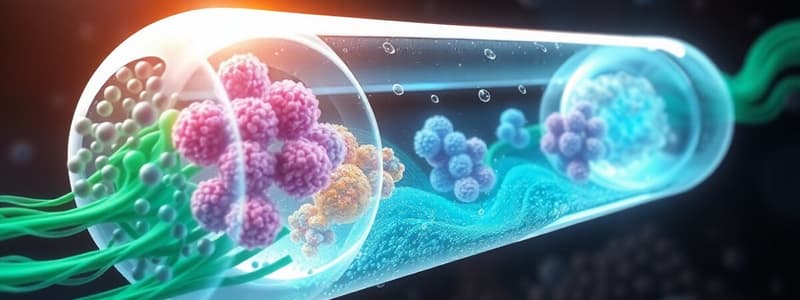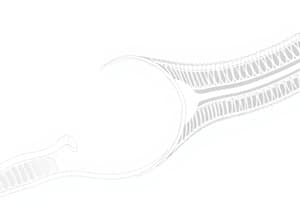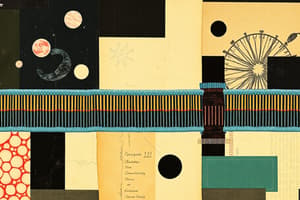Podcast
Questions and Answers
What is the structure found in both plant and animal cells that controls the movement of materials both in and out of the cell?
What is the structure found in both plant and animal cells that controls the movement of materials both in and out of the cell?
The cell membrane
What are the three main types of cellular transport?
What are the three main types of cellular transport?
- Diffusion, osmosis, endocytosis
- Passive transport, osmosis, active transport (correct)
- Diffusion, active transport, osmosis
- Osmosis, facilitated diffusion, endocytosis
The cell membrane is a selectively permeable barrier that allows all molecules to pass through.
The cell membrane is a selectively permeable barrier that allows all molecules to pass through.
False (B)
The cell membrane is made up of a double layer of ______.
The cell membrane is made up of a double layer of ______.
Which of the following is NOT a function of the cell membrane?
Which of the following is NOT a function of the cell membrane?
What type of transport requires energy?
What type of transport requires energy?
What is the movement of molecules from an area of high concentration to an area of low concentration called?
What is the movement of molecules from an area of high concentration to an area of low concentration called?
What type of transport involves the movement of molecules down their concentration gradient with the help of transport proteins embedded within the cell membrane?
What type of transport involves the movement of molecules down their concentration gradient with the help of transport proteins embedded within the cell membrane?
What is the movement of water from a region of high water concentration through a semi-permeable membrane to a region of low water concentration called?
What is the movement of water from a region of high water concentration through a semi-permeable membrane to a region of low water concentration called?
Match the following types of solutions with their effects on cells:
Match the following types of solutions with their effects on cells:
What type of active transport involves the engulfing of large particles by a cell?
What type of active transport involves the engulfing of large particles by a cell?
What type of active transport involves the cell taking in dissolved substances from the surrounding environment?
What type of active transport involves the cell taking in dissolved substances from the surrounding environment?
Active transport does not require energy.
Active transport does not require energy.
Which of the following are examples of passive transport?
Which of the following are examples of passive transport?
What type of active transport describes a cell secreting substances into the extracellular environment?
What type of active transport describes a cell secreting substances into the extracellular environment?
Flashcards
Cell Membrane
Cell Membrane
The thin outer layer of a cell that controls the passage of substances into and out of the cell.
Selective Permeability
Selective Permeability
The cell membrane's ability to let some molecules pass through while blocking others.
Phospholipid
Phospholipid
A type of lipid that forms the cell membrane's structure.
Phosphate Head
Phosphate Head
Signup and view all the flashcards
Lipid Tail
Lipid Tail
Signup and view all the flashcards
Membrane Proteins
Membrane Proteins
Signup and view all the flashcards
Transport (Channel) Protein
Transport (Channel) Protein
Signup and view all the flashcards
Diffusion
Diffusion
Signup and view all the flashcards
Facilitated Diffusion
Facilitated Diffusion
Signup and view all the flashcards
Osmosis
Osmosis
Signup and view all the flashcards
Hypertonic Solution
Hypertonic Solution
Signup and view all the flashcards
Hypotonic Solution
Hypotonic Solution
Signup and view all the flashcards
Isotonic Solution
Isotonic Solution
Signup and view all the flashcards
Active Transport
Active Transport
Signup and view all the flashcards
Endocytosis
Endocytosis
Signup and view all the flashcards
Phagocytosis
Phagocytosis
Signup and view all the flashcards
Pinocytosis
Pinocytosis
Signup and view all the flashcards
Exocytosis
Exocytosis
Signup and view all the flashcards
Passive Transport
Passive Transport
Signup and view all the flashcards
Cell Intake
Cell Intake
Signup and view all the flashcards
Cell Excretion
Cell Excretion
Signup and view all the flashcards
Cell Needs
Cell Needs
Signup and view all the flashcards
Cell Wastes
Cell Wastes
Signup and view all the flashcards
Simple Diffusion
Simple Diffusion
Signup and view all the flashcards
Passage of Materials
Passage of Materials
Signup and view all the flashcards
Cell Eating
Cell Eating
Signup and view all the flashcards
Cell Drinking
Cell Drinking
Signup and view all the flashcards
Cell Excreting
Cell Excreting
Signup and view all the flashcards
Cellular Transport
Cellular Transport
Signup and view all the flashcards
ATP (Adenosine Triphosphate)
ATP (Adenosine Triphosphate)
Signup and view all the flashcards
Study Notes
The Cell Membrane and Cellular Transport
- The cell membrane is found in both plant and animal cells.
- It controls the movement of materials into and out of the cell.
- The cell membrane is selectively permeable.
- Some molecules can pass through, and others cannot.
- This maintains the balance of the cell's internal environment.
Structure of the Cell Membrane
- Made up of a double layer of phospholipids.
- Phospholipids have a hydrophilic head and two hydrophobic tails.
- The hydrophilic heads face the outside and inside of the cell, while the hydrophobic tails face each other in the membrane's interior.
- Proteins are embedded within the membrane to help transport molecules.
- Various types of proteins, such as protein channels and carrier proteins, exist.
Membrane Proteins
- Proteins are embedded to prevent most molecules from passing through the hydrophobic lipid tails.
- Protein channels enable molecules to pass through the membrane without interacting with the lipids.
Transport (Channel) Proteins
- Shaped like tubes, forming channels through the cell membrane.
- Only allow certain molecules to pass through.
Cell Transport
- Includes diffusion, osmosis, and active transport.
- These processes allow the intake and release of substances.
Substances Absorbed by the Cell
- Sugars and fats are needed for covering energy consumption.
- Sugars and proteins are needed for cell construction.
- Proteins, hormones, and enzymes are needed for cell activity regulation.
- Water, ions, and vitamins are needed for conducting metabolic processes.
Substances Excreted by the Cell
- Carbon dioxide and urea are not needed or harmful.
- Enzymes, vitamins, and hormones are needed by other cells.
- Antibodies are needed for protection.
Passage of Materials through Cell Membranes
- Intake and release of substances are crucial for cell existence.
- Passive transport allows some molecules (e.g., water) to move in and out of cells easily without energy.
- Active transport requires energy and transport proteins to move other molecules across the membrane.
Simple Diffusion
- Movement of molecules from high to low concentration across the lipid bilayer.
- No energy is required.
- Examples include oxygen and carbon dioxide.
Facilitated Diffusion
- Movement of molecules down their concentration gradient with the help of transport proteins.
- No energy is required.
- Example: glucose.
Osmosis
- A specific type of diffusion involving the movement of water from high to low concentration across a semi-permeable membrane.
- No energy is required.
Diffusion vs. Osmosis
- Diffusion involves the movement of solutes (dissolved substances).
- Osmosis involves the movement of solvent (usually water).
Hypotonic Solution
- The solution outside the cell has a lower solute concentration than inside the cell.
- Water moves into the cell, causing it to swell and potentially burst.
Hypertonic Solution
- The solution outside the cell has a higher solute concentration than inside the cell.
- Water moves out of the cell, causing it to shrink.
Isotonic Solution
- The solute concentration outside the cell is equal to the solute concentration inside the cell.
- No net movement of water occurs.
Osmosis in Plant Cells
- Plant cells have cell walls that prevent them from bursting in hypotonic solutions.
- In a hypertonic solution, the cell membrane can detach from the cell wall resulting in plasmolysis.
Active Transport
- Movement of molecules from low to high concentration, requiring energy (ATP).
- Transport proteins embedded in the membrane facilitate this process.
Types of Active Transport
- Endocytosis: Cells engulf particles by surrounding and pinching off parts of the cell membrane.
- Phagocytosis: "Cell eating," engulfing large particles.
- Pinocytosis: "Cell drinking," taking in smaller dissolved ions or molecules.
- Exocytosis: Cells dispose of particles by enclosing substances in vesicles and fusing these vesicles with the cell membrane, releasing their contents.
Phagocytosis vs. Pinocytosis
- Phagocytosis is for larger particles, while pinocytosis is for smaller dissolved particles.
Passive vs. Active Transport
- Passive transport does not require energy and includes simple diffusion, facilitated diffusion, and osmosis.
- Active transport requires energy and includes endocytosis, exocytosis, and protein pumps.
Studying That Suits You
Use AI to generate personalized quizzes and flashcards to suit your learning preferences.




